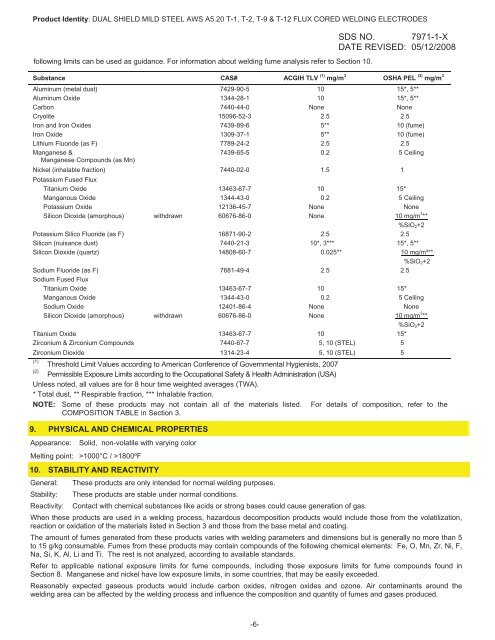Print MSDS - Miller Electric Company Publications
Print MSDS - Miller Electric Company Publications
Print MSDS - Miller Electric Company Publications
You also want an ePaper? Increase the reach of your titles
YUMPU automatically turns print PDFs into web optimized ePapers that Google loves.
Product Identity: DUAL SHIELD MILD STEEL AWS A5.20 T-1, T-2, T-9 & T-12 FLUX CORED WELDING ELECTRODES<br />
following limits can be used as guidance. For information about welding fume analysis refer to Section 10.<br />
Substance CAS# ACGIH TLV (1) mg/m 3<br />
-6-<br />
SDS NO. 7971-1-X<br />
DATE REVISED: 05/12/2008<br />
OSHA PEL (2) mg/m 3<br />
Aluminum (metal dust) 7429-90-5 10 15*, 5**<br />
Aluminum Oxide 1344-28-1 10 15*, 5**<br />
Carbon 7440-44-0 None None<br />
Cryolite 15096-52-3 2.5 2.5<br />
Iron and Iron Oxides 7439-89-6 5** 10 (fume)<br />
Iron Oxide 1309-37-1 5** 10 (fume)<br />
Lithium Fluoride (as F) 7789-24-2 2.5 2.5<br />
Manganese &<br />
Manganese Compounds (as Mn)<br />
7439-65-5 0.2 5 Ceiling<br />
Nickel (inhalable fraction) 7440-02-0 1.5 1<br />
Potassium Fused Flux<br />
Titanium Oxide<br />
Manganous Oxide<br />
Potassium Oxide<br />
Silicon Dioxide (amorphous) withdrawn<br />
13463-67-7<br />
1344-43-0<br />
12136-45-7<br />
60676-86-0<br />
10<br />
0.2<br />
None<br />
None<br />
15*<br />
5 Ceiling<br />
None<br />
10 mg/m 3 **<br />
%SiO2+2<br />
Potassium Silico Fluoride (as F) 16871-90-2 2.5 2.5<br />
Silicon (nuisance dust) 7440-21-3 10*, 3*** 15*, 5**<br />
Silicon Dioxide (quartz) 14808-60-7 0.025** 10 mg/m³**<br />
%SiO2+2<br />
Sodium Fluoride (as F) 7681-49-4 2.5 2.5<br />
Sodium Fused Flux<br />
Titanium Oxide<br />
Manganous Oxide<br />
Sodium Oxide<br />
Silicon Dioxide (amorphous) withdrawn<br />
13463-67-7<br />
1344-43-0<br />
12401-86-4<br />
60676-86-0<br />
10<br />
0.2<br />
None<br />
None<br />
15*<br />
5 Ceiling<br />
None<br />
10 mg/m 3 **<br />
%SiO2+2<br />
Titanium Oxide 13463-67-7 10 15*<br />
Zirconium & Zirconium Compounds 7440-67-7 5, 10 (STEL) 5<br />
Zirconium Dioxide 1314-23-4 5, 10 (STEL) 5<br />
(1)<br />
Threshold Limit Values according to American Conference of Governmental Hygienists, 2007<br />
(2)<br />
Permissible Exposure Limits according to the Occupational Safety & Health Administration (USA)<br />
Unless noted, all values are for 8 hour time weighted averages (TWA).<br />
* Total dust, ** Respirable fraction, *** Inhalable fraction.<br />
NOTE: Some of these products may not contain all of the materials listed. For details of composition, refer to the<br />
COMPOSITION TABLE in Section 3.<br />
9. PHYSICAL AND CHEMICAL PROPERTIES<br />
Appearance: Solid, non-volatile with varying color<br />
Melting point: >1000°C / >1800ºF<br />
10. STABILITY AND REACTIVITY<br />
General: These products are only intended for normal welding purposes.<br />
Stability: These products are stable under normal conditions.<br />
Reactivity: Contact with chemical substances like acids or strong bases could cause generation of gas.<br />
When these products are used in a welding process, hazardous decomposition products would include those from the volatilization,<br />
reaction or oxidation of the materials listed in Section 3 and those from the base metal and coating.<br />
The amount of fumes generated from these products varies with welding parameters and dimensions but is generally no more than 5<br />
to 15 g/kg consumable. Fumes from these products may contain compounds of the following chemical elements: Fe, O, Mn, Zr, Ni, F,<br />
Na, Si, K, Al, Li and Ti. The rest is not analyzed, according to available standards.<br />
Refer to applicable national exposure limits for fume compounds, including those exposure limits for fume compounds found in<br />
Section 8. Manganese and nickel have low exposure limits, in some countries, that may be easily exceeded.<br />
Reasonably expected gaseous products would include carbon oxides, nitrogen oxides and ozone. Air contaminants around the<br />
welding area can be affected by the welding process and influence the composition and quantity of fumes and gases produced.



